|
Mad Scientists and Monstrous Creations:
The Continuation of the
Frankenstein Myth in
Modern Science Fiction and Horror Films
Artificial human beings and their creators have become a standard ingredient
of modern science fiction/horror films and literature. In the horror genre
these creatures are usually not very different from those in various Frankenstein movies, although bearing no direct reference to Mary
Shelley and Frankenstein. In science fiction the artificial beings
often lack the monstrous and scary features of the Frankenstein monster and appear in mechanised form as robots, androids and cyborgs (= cybernetic organisms), most prominently in the stories of Isaac Asimov
and Stanislav Lem.
Generally
regarded the earliest fully realised cinematic robot is Maria from
Metropolis (Germany 1927; dir: Fritz Lang). Lustful mad scientist Rotwang
creates Maria to reflect his vision of the perfect submissive woman. But
Maria rebels against her creator and provokes a worker revolt that threatens
to destroy the entire city. At the end, she is burned at the stake as a kind
of witch. Apart from being the first movie with a robot, Metropolis also
proved to be a major stylistic influence on James Whale's Frankenstein movies.
Just as
Mary Shelley's novel influenced many other writers or inspired them to write
continuations and adaptations, the huge number of Frankenstein movies
spawned an even greater number of films about mad scientists and their
human creations. Most of them are forgettable and can easily be dismissed
as trash. Still, there are a few films worth mentioning that adapt aspects
of Victor Frankenstein's story in a very intelligent way, yet without naming
their source or making direct references to Frankenstein.
|

Maria, the Robot from Metropolis |
In fact most
cinematic variations of the Frankenstein/mad scientist theme, including many Hammer and Universal
Frankenstein films, can be reduced to the simple formula: "Scientist
creates monster - monster runs berserk - justice is done to the scientist by
the hands of his own creation". Many film producers and screenwriters
have adapted this formula with varying degrees of success, including the
following examples, which have at least added interesting original ideas to
the simple basic plot.
A distinguishing feature of more recent - and also seemingly more serious -
"mad scientist" movies is the fact that the artificial being is no longer
stitched together from dead body parts. Some of these tales are far removed
from the Frankenstein story in that they even abandon the concept of a
human-like monster. The 1950s and 60s were flooded with
radioactive monsters and mutated giant insects (Them!, Formicula), the
1970s saw the advance of
computers and out-of-control artificial
intelligence or frightened cinema audiences with eco-horror in the form of rampaging insects or giant
sharks. In the 1980s the obsession with technology, an enormous advance of computer
science and a general atmosphere of technophobia found its cinematic mirror in
robotic monsters and cyborg killer machines. The best known examples are
the Terminator
movies starring Arnold Schwarzenegger as the
indestructible, merciless killer from the future.
With the advance of genetic engineering and first successes in cloning, Hollywood needed a new breed of monster, where tampering with human DNA replaced the lightning bolt and stitching needles
from James Whale's films.
However, at all times, more "traditional" adaptations of the
Frankenstein plot featuring re-animated corpses and body parts, mostly B movies
and direct-to-video fare, still managed to attract the horror audience.
Blade Runner (1982)
One
of the best films about artificial humans is Blade Runner (USA 1982), a
science fiction movie directed by Ridley Scott and written by Hampton
Fancher and David Peoples, based on Philip K. Dick's (1928-1982) story
"Do Androids Dream of Electric Sheep?" (1969). It is set in the
future Los Angeles of 2019, a huge polluted megalopolis with continuous
rainfall, billboards hundreds of feet high and towering skyscrapers of
unimaginable height.
The plot centers around so-called "replicants",
genetically engineered human beings designed as cheap labour force in
outworld (planetary) colonies. After an uprising five replicants return to
earth because they do not want to live a life as slaves anymore. Since they
only have a limited life span of four years they seek out their
"maker" Doctor Tyrell, the president of a huge hi-tech
corporation. Their aim is to force Tyrell to improve them and to give them
more life. When Tyrell reveals to them that this is technically impossible, Batty, the leader of the replicants, kills him.
|
Blade Runner
shows some remarkable parallels with Frankenstein. The film's artificial humans, the replicants, are thrown into a society that
does not want them. Because people are afraid of the replicants' superior
physical powers, a special police unit was established: the Blade Runners, whose sole aim is to eliminate - the film calls it "to
retire" - replicants who have returned to earth. When Batty, the leader
of the renegade replicants, is not
granted his wish for more life, similar to the Monster's wish for a bride in
Frankenstein, he destroys "his Victor Frankenstein", Doctor
Tyrell, the man who created him and whom he accordingly addresses as
"father".
|

Monster (Rutger Hauer as the replicant Roy Batty) ....

...and
hunter (Harrison Ford als Rick Deckard, the Blade Runner)
|
Like Victor Frankenstein, Doctor Tyrell is far from being a benign father
figure, but rather treats his creations with cruelty. First Tyrell gives the
replicants life but then he abandons them, releases them into human society and
refuses to care for them anymore. The viewer's sympathy is rather on the
side of the replicant Batty than on Tyrell's or the Blade Runner's side.
Like the Monster in Frankenstein, the replicant Roy Batty only acts violently because he is rejected by a paranoid society and
left alone by his father. He is victimized by human society simply because of
his status as an artificial being, as someone who is different from - and in
many aspects superior to - other human beings.
But not all replicants in Blade Runner are like the Frankenstein Monster,
who is aware that he is not human. Blade Runner confronts us with a far more
disturbing utopia: the Tyrell Corporation's latest and most advanced
replicant model is
a female who does not know that she is artificial due to her
possessing the implanted memories of an actual human being. The film also
raises the question whether Deckard, the Blade Runner, is such a replicant
or not. There are several theories confirming or denying Deckard's
replicant status, although director Ridley Scott has repeatedly stated that
he sees Deckard as a replicant.
Star Trek - The Next Generation
(1987-1994)
|
One of the main protagonists
in the popular science fiction TV series Star
Trek - The Next Generation is an android named Data. Despite his
somewhat monstrous appearance (pale skin, life-less eyes), Data, an
artificial being like Frankenstein's Monster, is fully integrated into the
society of the 23rd century as the commander of the starship U.S.S.
Enterprise. But not only in this aspect Data is a reversion of the
Frankenstein Monster. In Shelley's novel the creature is endowed with human
emotions but lacks knowledge of the society and culture it is thrown into.
Data, on the contrary, has all the knowledge of mankind stored in his
brain's computer memory banks, but is incapable of showing human emotions
and feelings. Therefore his main goal is to learn emotions and to become
more human.
|
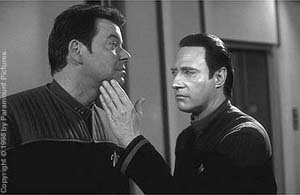
The android Data (Brent Spiner, right)
and Commander Riker (Jonathan Frakes, left)
|
In Star Trek, a sometimes very naive utopia, many of the
questions raised in Mary Shelley's Frankenstein are finally answered. In the
interplanetary society of the 23rd century every being is accepted, no matter how
strange or horrible they look. Scientific progress, in Shelley's
times "promethean transgression", is acceptable because it is
pursued with responsibility and only for the benefit of mankind.
Star Trek contains yet another parallel with Frankenstein: In
the episode "Brothers" (1990; directed by Rob Bowman, written by Rick
Berman), Data's creator,
Professor Noonian Soong, is destroyed by his own creation. But it
is not the benevolent Data, who is responsible for Soong's demise. Data's evil twin "brother" Lore kills Soong after stealing
an emotion chip originally designed for Data. Just like in the novel, the
aggressive attitude of the creation causes the death of its creator (cf. Specht-Jarvis 1994: 141). Of course not even the society of the
23rd century could have accepted a being like Frankenstein's Monster with
such a capacity for evil. Therefore the authors of Star Trek had to split up
the Monster into two persons (Data and Lore), like Dr. Jekyll and Mr. Hyde,
or, more adequate, like the Biblical brothers Cain and Abel.
Robocop (1987)
Another "Frankensteinian"
monster appears in Paul Verhoeven's Robocop (1987), a
hyper-violent, yet marvellously satiric science fiction film. Robocop, "the
future of law enforcement", is a cyborg, part man, part machine, with
the head and brain of a murdered police officer attached to a virtually indestructible metal torso. While on the surface Robocop is no more
than a cheap B-movie spiced-up with over-the-top violence, it is also the
story of a monster searching for its identity. One scene, in particular, is
reminiscent of Mary Shelley's novel: when Robocop puts off his helmet for the
first time he sees the reflection of his face in a mirror - just like
Frankenstein's Monster saw his face in a pond. At that moment, Robocop, whose
memories of his former life have been erased by scientists, realises that in
fact he is still a human being, the police officer Murphy.
|
Robocop also contains one of the most important basic plot elements of Frankenstein:
the Monster is finally responsible for the demise of its creator. After
finding out that the president of OCP, the hi-tech company that built him,
is a corrupt and murderous villain, Robocop returns to his
"birthplace" and kills him.
Here the
Monster is practically made the executive organ of poetic justice; the
Monster is judge, jury and executioner in one person. |
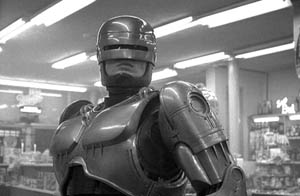
Cop-in-a-can: Peter Weller as Robocop/Murphy |
Re-Animator
(1985)
|
Re-Animator
(USA 1985; dir: Stuart Gordon) is based upon a short story by American horror and fantasy writer
H.P.Lovecraft (1890-1937). The story of Herbert West (both in the short
story and in the movie), a medical student who
invents a serum to bring dead bodies back to life, is surely influenced by
Mary Shelley's novel. Like in Frankenstein, Herbert West's creation turns
against him when he has to face a horde of blood-thirsty undead beings
re-animated by his serum. Both the original short story and the film
remain on a very superficial level because none of them give a clear
explanation of why the re-animated become aggressive killers. Some
simply wake up and instinctively kill like animals, while others retain
memories of their former life. One of them is Herbert West's rival Dr.
Hill, who continues his plan to destroy West once he is re-animated. |
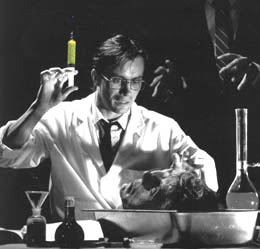
Herbert West (
Jeffrey Combs)
injects life in Re-Animator
|
| The
sequel Bride of Re-Animator (USA
1990; dir: Brian Yuzna) was intended as a homage to
James Whale's Bride of Frankenstein.
Having improved his serum, this time Herbert West experiments with the
re-animation of body parts and grotesque creations such as flying head with
bat wings. Herbert West finally creates a bride for himself out of dead body
parts but the female monster falls in love with West's
assistant Daniel Caine instead. When she realises that she is just a
collection of dead parts rather than a human being, she destroys herself by
tearing herself to pieces.
|
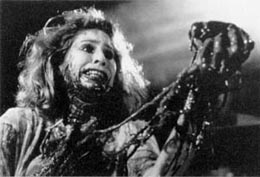
Frankenstein enters the age of splatter films:
Kathleen Kinmont in Bride of Re-Animator |
|
The third film in the series, entitled Beyond Re-Animator
(Spain 2003, dir: Brian Yuzna) is set thirteen years after the events of Bride
of Re-Animator. Herbert West is now incarcerated in a maximum security
prison, where he is able to continue his experiments with the assistance of a
young doctor, Dr. Howard Philips. In addition to re-animating dead bodies
with his green liquid, West also injects them with "nano-plasmic energy",
basically the soul of a being captured at the moment of death. The
experiments, however, go awfully wrong and West ends up fighting dozens of
rampaging inmates, some of them chopped in half, others disemboweled.
|
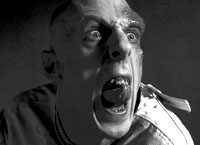
Another unfortunate victim meets
his demise in Beyond Re-Animator |
| The idea of putting someone
else's soul into a human body was previously used in Hammer's
Frankenstein
Created Woman. Beyond Re-Animator plays like a homage
to this Hammer classic, when West injects a gorgeous woman with the nano-plasma
of her murderer, the prison warden. Consequently, both souls then
struggle in the woman's body, alternately taking possession of her and
turning her into a bloodlusty monster. Therefore it owes much more to
old Hammer movies (and the prison riot scenes in Oliver Stone's Natural
Born Killers) than to any other Frankenstein adaptation. In fact, all
three Re-Animator films don't borrow a lot from their literary source,
which producer/director Brian Yuzna repeatedly admitted when he stated
that they "are not really Lovecraft". |
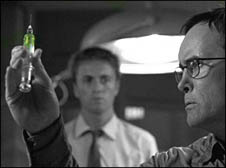
West and his new assistant (Jason Barry) fill
up their syringes. |
The horror in both Re-Animator and its sequel Bride of Re-Animator
surely cannot be compared to the tame frights (by today's standards) of
Boris Karloff's Frankenstein or Peter Cushing's experiments with dead
bodies. The Re-Animator series perfectly
fits into the sub-genre of "splatter" movies, basically for the
extensive use of
images of extremely gory, over-the-top violence. Instead of leaving the gruesome details to the
viewer's imagination, splatter movies frighten and disgust the audience with explicit
details of mutilated bodies and gaping wounds. Their main shock value lies in showing the biological
side of horror and in demonstrating the vulnerability of the human body.
Therefore it does
not quite come as a surprise that the Re-Animator films were censored in many countries
and heavily cut by censorship boards such as the "British Board of Film
Classification" and the MPAA when they were first
released. This is a fate the
Re-Animator films share with the early Frankenstein films, which due to their controversial
content often caused censors to act and cut.
However, the Re-Animator films lighten up their Grand Guignol-esque
gore escapades by mixing the violence with elements of dark comedy. The
sheer excess and exaggeration of on-screen violence paired with dark humor
intends to make the viewers rather laugh than cover their eyes in terror,
just like in Monty Python's The Meaning of Life, where characters are
disemboweled and cut into slices for humorous effect.
The plot device of "mad scientist + monster on the run" has long
been a standard ingredient of horror movies and is exploited in numerous
cinematic works, often in the low-budget range, but also by A-list Hollywood
productions.
 |
In
Roger Donaldson's Species (1995) scientist Xavier Fitch (Ben
Kingsley) creates a female monster by crossing human and alien DNA. This
creature, named Sil, is not only exceptionally good-looking but also has the unpleasant
habit of killing men after having sex with them. After the female monster has undergone
a horrible metamorphosis into a tentacled beast (courtesy of Swiss
painter H.R. Giger) she brutally slays her creator Fitch.
Natasha Henstridge as Sil, before becoming an abomination from
H.R.Giger's imagination. |
In acclaimed horror director Wes Craven's The
Deadly Friend (1986) 15-year old science wiz kid Paul
(Matthew Laborteaux)
creates an intelligent robot named BB, which is shot to
pieces on Halloween by an elderly woman. Soon after, Paul's girlfriend Samantha (Kristy Swanson)
is killed by her abusive father. Paul decides to resurrect
Samantha by implanting
BB's computer brain into her head. Unfortunately she comes back as a completely different person: a
vengeful femme fatale
endowed with superhuman strength, yet mute and displaying robot-like
movements.
Samantha then goes on to take revenge on all
those who mistreated her in her former life: She breaks her
father's neck and burns his corpse and later kills the old woman,
who destroyed BB, by smashing her head with a basketball. Before she can kill more people
Samantha is eventually shot by the police.
What could have been a successfully modernised take on the
Hammer Frankenstein formula - in particular Frankenstein
Created Woman and Frankenstein Must Be Destroyed -, turns out
a silly 1980s trash B-horror. Although Deadly Friend has several
good moments (suspenseful killing scenes, atmospheric music and a couple
of scenes, where Samantha finds out what she actually is), it is ultimately ruined by
too many ill-conceived elements: the screenplay and direction are mostly
incoherent, the
cutie robot BB rather belongs in a kiddie movie, most characters are too
stereotypical. Worst of all is the sheer unbelievable fact that the
movie's hero is a school kid, who can single-handedly create a robot
with artificial intelligence and knows more about brain surgery than any
scientist at university. With a more adult target group in mind, the
screenwriters could have created a far better movie. |
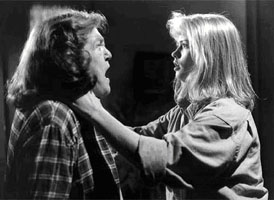
Samantha (Kirsty Swanson) has a smashing argument with
her elderly neighbor (Anne Ramsey)
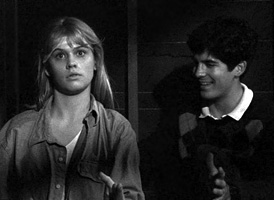
Paul shows Samantha how to walk again |
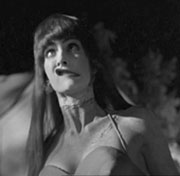
Gorgeous face: Patty Mullen as
Elizabeth in Frankenhooker |
A
similar plot is the basis of Frank Henenlotter's (creator of low-budget
splatter movies such as Basketcase and Brain Damage) black comedy Frankenhooker
(1990). After his girlfriend is killed in a freak accident
involving a lawnmower, mad medical student Jeffrey Franken blows up a
couple of street hookers with hyper-charged crack crystals. Using their
body parts, he brings back his girlfriend, who then goes on a rampage and
kills off several men during sexual intercourse. Although crude, silly and
badly written, the movie has some funny moments, especially those
involving the re-animated hooker, who takes on one of Karloff's most
famous lines from Bride of Frankenstein: "Pretzel - good!" |

Two Frankenstein monsters: Ripley (Weaver)
and the android Annalee (Ryder) |
The fourth part of the Alien series, Alien Resurrection (USA 1997,
dir: Jean-Pierre Jeunet), starts off with the
premise that heroine Ellen Ripley (Sigourney Weaver) is getting cloned by a team of
military scientists and genetically blended with DNA from the aggressive Aliens. The
result is a fairly monstrous Ripley, endowed with superhuman strength and acid
for blood, who is constantly torn between her human and Alien side. Being
both a threat and a rescuer, Ripley delivers death to her corrupt makers - a
team of mad scientists and army members - and saves a band of humans. Among
these humans is the movie's second Frankenstein monster, an android (Winona
Ryder) whose
self-imposed mission is to save mankind from the deadly Alien race created
in the Army laboratories.
|

© 1999-2007
Andreas Rohrmoser
|


